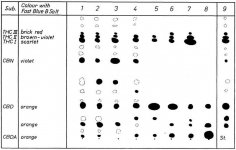
A = CBD Therapy - Veg phase, 40 days from seed
B = Dinamed - Veg phase, 24 days from seed
C = Dinamed - 2wks into flower phase
D = Dinamed - 4.5wks into flower phase
E = CBD Therapy - harvested 55 days into flower
F = Dinamed - harvested 61 days into flower
Only lanes A and E are showing CBD (the large orange dot above the red dot near the top of the plate)
The Dinamed CBD was a disappointing result -- no CBD at all from this particular phenotype. The first Dinamed i grew was 1:1.













